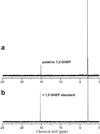Molecular cloning and heterologous expression of the dehydrophos biosynthetic gene cluster
- PMID: 20416511
- PMCID: PMC2888486
- DOI: 10.1016/j.chembiol.2010.03.007
Molecular cloning and heterologous expression of the dehydrophos biosynthetic gene cluster
Abstract
Dehydrophos is a vinyl phosphonate tripeptide produced by Streptomyces luridus with demonstrated broad-spectrum antibiotic activity. To identify genes necessary for biosynthesis of this unusual compound we screened a fosmid library of S. luridus for the presence of the phosphoenolpyruvate mutase gene, which is required for biosynthesis of most phosphonates. Integration of one such fosmid clone into the chromosome of S. lividans led to heterologous production of dehydrophos. Deletion analysis of this clone allowed identification of the minimal contiguous dehydrophos cluster, which contained 17 open reading frames (ORFs). Bioinformatic analyses of these ORFs are consistent with a proposed biosynthetic pathway that generates dehydrophos from phosphoenolpyruvate. The early steps of this pathway are supported by analysis of intermediates accumulated by blocked mutants and in vitro biochemical experiments.
(c) 2010 Elsevier Ltd. All rights reserved.
Figures






Similar articles
-
Molecular cloning, sequence analysis, and heterologous expression of the phosphinothricin tripeptide biosynthetic gene cluster from Streptomyces viridochromogenes DSM 40736.Antimicrob Agents Chemother. 2005 Jan;49(1):230-40. doi: 10.1128/AAC.49.1.230-240.2005. Antimicrob Agents Chemother. 2005. PMID: 15616300 Free PMC article.
-
Cloning, heterologous expression, and characterization of the gene cluster required for gougerotin biosynthesis.Chem Biol. 2013 Jan 24;20(1):34-44. doi: 10.1016/j.chembiol.2012.10.017. Chem Biol. 2013. PMID: 23352137
-
Cloning and nucleotide sequence of fosfomycin biosynthetic genes of Streptomyces wedmorensis.Mol Gen Genet. 1995 Nov 27;249(3):274-80. doi: 10.1007/BF00290527. Mol Gen Genet. 1995. PMID: 7500951
-
Bialaphos.Biotechnology. 1995;28:197-222. doi: 10.1016/b978-0-7506-9095-9.50014-9. Biotechnology. 1995. PMID: 8688624 Review. No abstract available.
-
Structure and mechanism of enzymes involved in biosynthesis and breakdown of the phosphonates fosfomycin, dehydrophos, and phosphinothricin.Arch Biochem Biophys. 2011 Jan 1;505(1):13-21. doi: 10.1016/j.abb.2010.09.012. Epub 2010 Sep 18. Arch Biochem Biophys. 2011. PMID: 20854789 Free PMC article. Review.
Cited by
-
Revisiting the biosynthesis of dehydrophos reveals a tRNA-dependent pathway.Proc Natl Acad Sci U S A. 2013 Jul 2;110(27):10952-7. doi: 10.1073/pnas.1303568110. Epub 2013 Jun 17. Proc Natl Acad Sci U S A. 2013. PMID: 23776232 Free PMC article.
-
Recent examples of α-ketoglutarate-dependent mononuclear non-haem iron enzymes in natural product biosyntheses.Nat Prod Rep. 2018 Aug 15;35(8):792-837. doi: 10.1039/c7np00067g. Nat Prod Rep. 2018. PMID: 29932179 Free PMC article. Review.
-
Conserved biosynthetic pathways for phosalacine, bialaphos and newly discovered phosphonic acid natural products.J Antibiot (Tokyo). 2016 Jan;69(1):15-25. doi: 10.1038/ja.2015.77. Epub 2015 Sep 2. J Antibiot (Tokyo). 2016. PMID: 26328935 Free PMC article.
-
Structure-activity relationships of the phosphonate antibiotic dehydrophos.Chem Commun (Camb). 2010 Nov 7;46(41):7694-6. doi: 10.1039/c0cc02958k. Epub 2010 Sep 27. Chem Commun (Camb). 2010. PMID: 20871915 Free PMC article.
-
Determining biosynthetic gene cluster boundaries through comparative bioinformatics.Methods Enzymol. 2025;717:241-265. doi: 10.1016/bs.mie.2025.04.001. Epub 2025 May 16. Methods Enzymol. 2025. PMID: 40651826
References
-
- Altschul S, Gish W, Miller W, Myers E, Lipman D. Basic local alignment search tool. J Mol Biol. 1990;215:403–410. - PubMed
-
- Biarrotte-Sorin S, Maillard A, Delettré J, Sougakoff W, Arthur M, Mayer C. Crystal structures of Weissella viridescens FemX and its complex with UDP-MurNAc-pentapeptide: insights into FemABX family substrates recognition. Structure. 2004;12:257–267. - PubMed
-
- Bowman E, McQueney M, Barry RJ, Dunawaymariano D. Catalysis and thermodynamics of the phosphoenolpyruvate phosphonopyruvate rearrangement - entry into the phosphonate class of naturally-occurring organophosphorus compounds. Journal of the American Chemical Society. 1988;110:5575–5576.
Publication types
MeSH terms
Substances
Grants and funding
LinkOut - more resources
Full Text Sources
Other Literature Sources
Medical
Molecular Biology Databases

